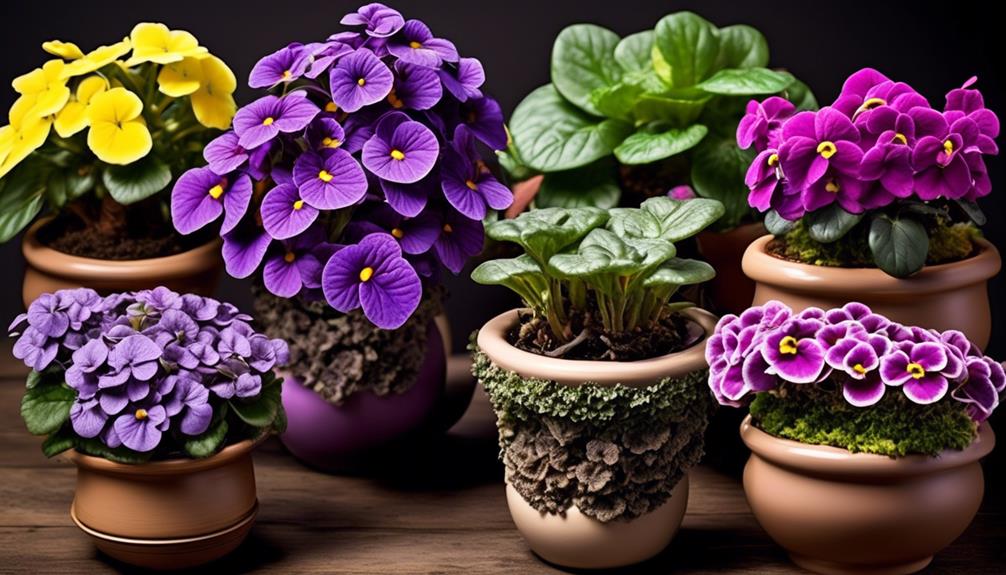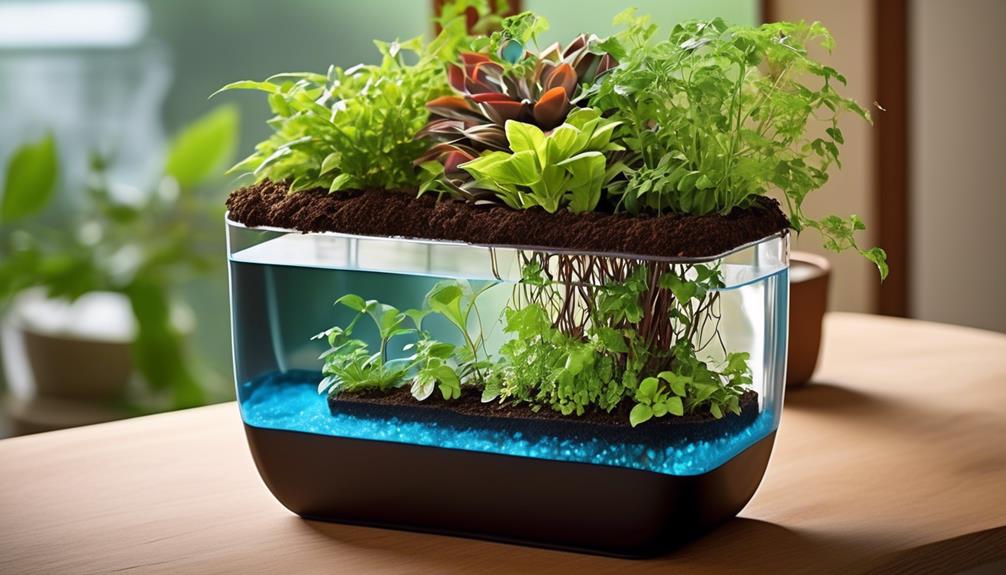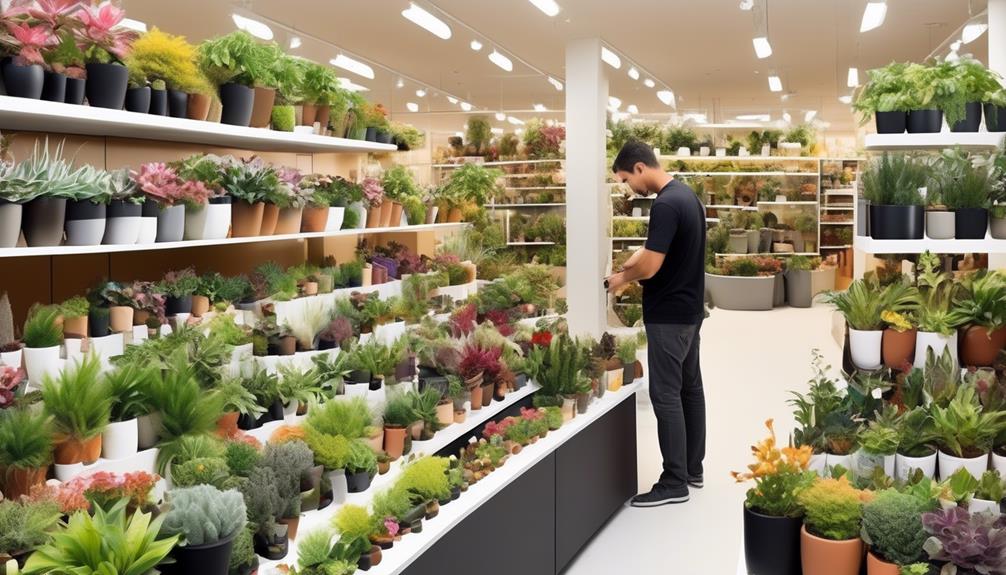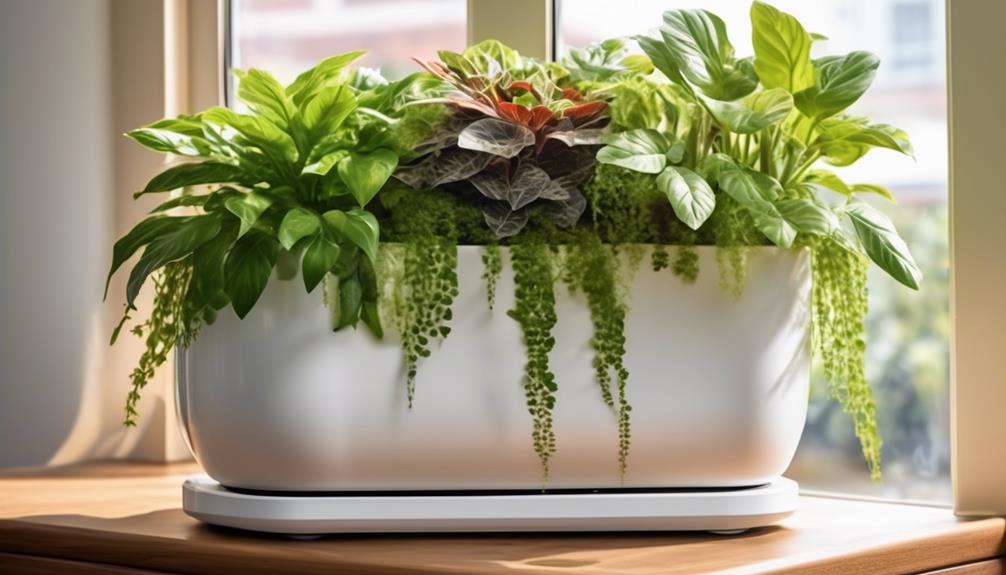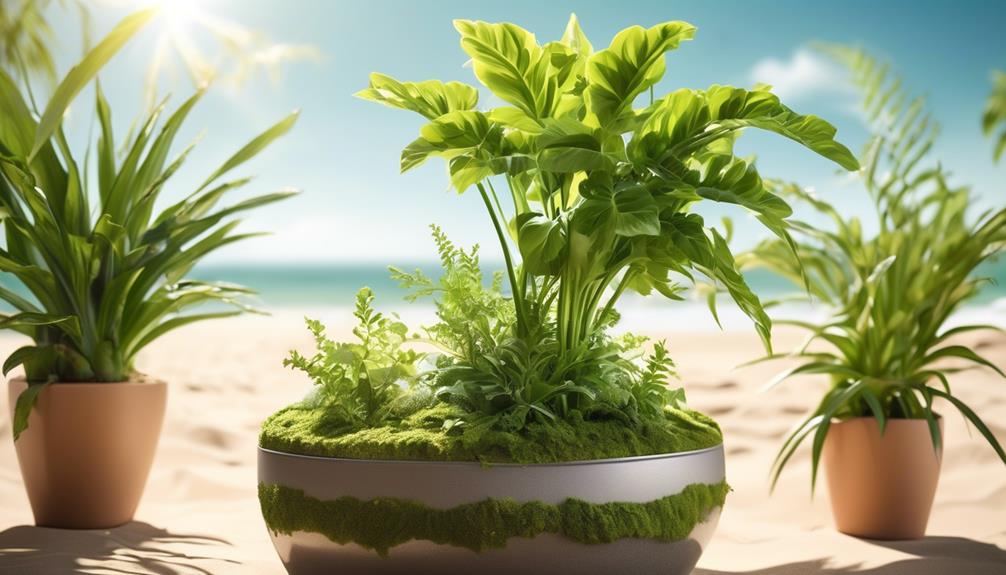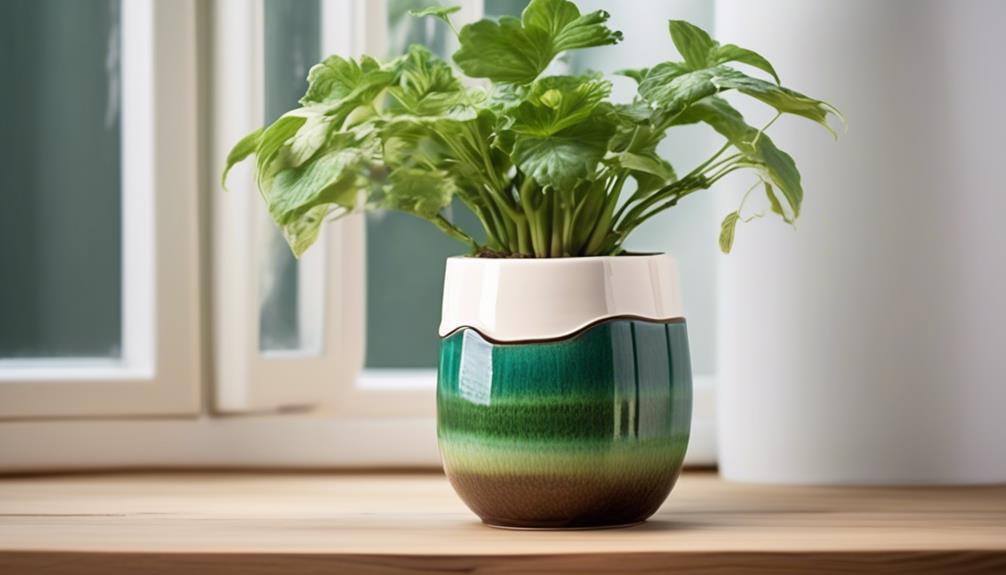When it comes to transferring African violets to self-watering pots, there is often a spirited discussion about the optimal pot size for these delicate flowers. Selecting the perfect pot size is crucial for the well-being and development of these stunning blooms, but determining the ideal size can be as challenging as solving a complex puzzle.
I'm sure many of us have experienced the frustration of choosing pots that seemed perfect, only to realize they weren't quite right for our African violets. However, fear not! In this discussion, we'll unravel the mystery of pot sizes for African violets in self-watering pots, providing insights and tips to help you make the best choice for your beloved plants.
Key Takeaways
- Pot size directly impacts the root system and water retention/drainage balance of African violets.
- The recommended pot size for African violets in self-watering pots is 4 to 6 inches in diameter.
- Choosing the correct pot size reduces the risk of over or under-watering and promotes healthy growth.
- Maintaining optimal conditions for African violets in self-watering pots includes monitoring soil moisture, providing indirect bright light, and maintaining a humid environment.
Importance of Pot Size
When selecting a pot size for planting African violets in self-watering pots, it's essential to consider the root system's space requirements and the overall balance between water retention and drainage. Choosing the correct size pot plays a crucial role in the healthy growth of African violets. A pot that's too small can restrict the root system, leading to stunted growth and poor nutrient uptake. On the other hand, a pot that's too large can lead to waterlogging, which can cause root rot and other moisture-related issues. Therefore, selecting the proper size pot is vital for the overall well-being of the plant.
The benefits of choosing the correct pot size are numerous. Firstly, it provides adequate space for the development of the root system, allowing the plant to absorb water and nutrients efficiently. Secondly, it helps in maintaining the right balance between water retention and drainage. A well-fitted pot ensures that excess water can drain out, preventing waterlogging, while also retaining enough moisture for the plant's needs.
Recommended Pot Sizes
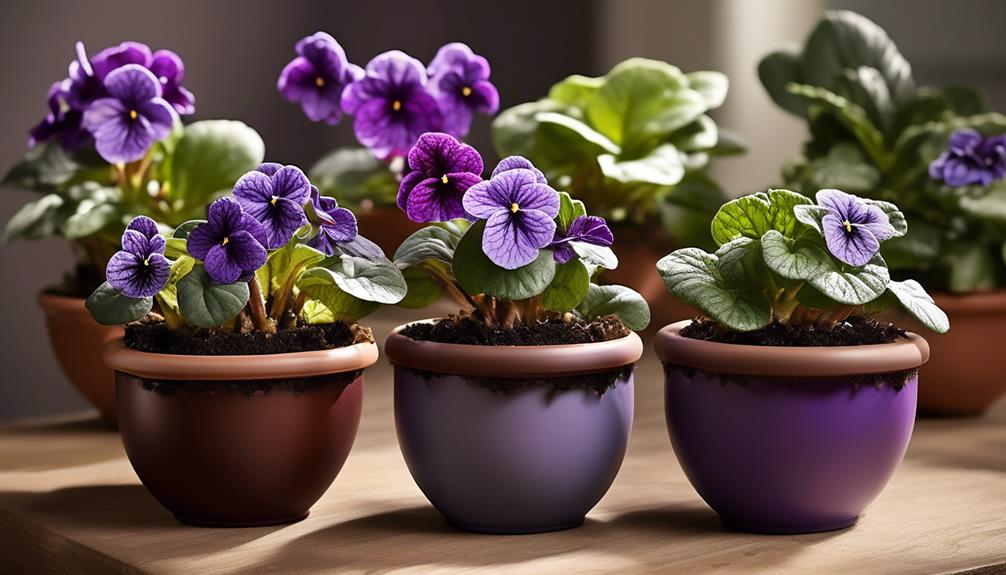
For optimal growth and health of African violets in self-watering pots, the recommended pot sizes range from 4 to 6 inches in diameter. Choosing the right pot size is crucial for the well-being of your African violets, as it directly impacts watering frequency and root development. Below is a table detailing the recommended pot sizes for different stages of African violet growth:
| Stage of Growth | Pot Size (Diameter) |
|---|---|
| Young plant | 4 inches |
| Mature plant | 6 inches |
| Multiple plants | 6 inches |
| Small arrangement | 4 inches |
| Large arrangement | 6 inches |
Selecting the appropriate pot size ensures the right amount of water is delivered to the plant, reducing the risk of over or under-watering. This directly influences the watering frequency, allowing for a more consistent and balanced moisture level for the African violets. Additionally, the correct pot size encourages healthy root development, providing ample space for the roots to grow and support the plant's overall health.
Factors to Consider
Considering the environmental conditions and the specific needs of the African violets is essential when selecting the appropriate pot size for optimal growth and health.
Watering frequency and soil moisture are crucial factors to consider. African violets require consistently moist but not waterlogged soil. Therefore, choosing a pot size that accommodates the right amount of soil to retain moisture without causing waterlogging is essential. The pot should also have adequate drainage to prevent water from accumulating at the bottom, which can lead to root rot.
Additionally, the size of the pot will influence the watering frequency. Larger pots hold more soil, which retains moisture for a longer time, thereby reducing the frequency of watering. Conversely, smaller pots dry out more quickly and may require more frequent watering. It's important to strike a balance and choose a pot size that aligns with the watering routine you can maintain.
Potting Tips
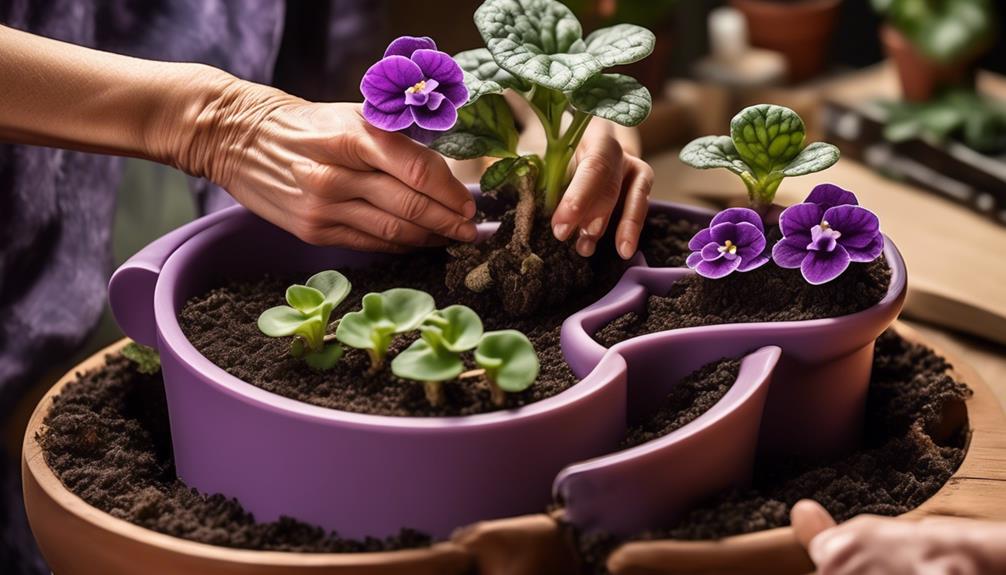
To ensure successful potting of African violets in self-watering pots, carefully select a well-draining potting mix specifically formulated for these delicate plants. When potting African violets, it's crucial to use a soil mix that retains enough moisture for the plants to thrive but also drains well to prevent waterlogging. Look for a mix designed for African violets or create a custom blend using peat moss, vermiculite, and perlite to achieve the right balance of moisture retention and drainage.
When potting, ensure that the soil is moist but not soggy before planting the African violets. Gently remove the plant from its original container and place it in the center of the new self-watering pot, adding more soil mix around the edges to fill the container. Be careful not to bury the crown of the plant too deeply.
After potting, water the African violet from the bottom by pouring water into the self-watering pot's reservoir. Monitor the soil moisture regularly to determine the watering frequency, and adjust as needed to maintain optimal growing conditions for the African violets.
Maintaining Optimal Conditions
Maintain optimal conditions for African violets in self-watering pots by regularly monitoring the soil moisture and adjusting the watering frequency as needed to support their growth.
- Watering Frequency: It's crucial to maintain a consistent watering schedule, allowing the soil to dry slightly between waterings. Overwatering can lead to root rot, while underwatering can cause wilting.
- Light Exposure: Ensure your African violets receive the right amount of light. Indirect, bright light is ideal. Too much direct sunlight can scorch the leaves, while too little light can hinder blooming.
- Humidity Levels: African violets thrive in humid environments. To maintain optimal conditions, consider placing a humidity tray or a small humidifier near the plants.
Regularly check the soil moisture by inserting your finger into the soil. If it feels dry to the touch, it's time to water. Adjust the watering frequency based on the plant's needs, which can vary with changes in temperature and humidity.
Additionally, ensure your violets receive adequate, indirect light to promote healthy growth and vibrant blooms. By carefully monitoring these factors, you can provide the optimal conditions necessary for the flourishing of your African violets.
Frequently Asked Questions
Can I Use a Regular Potting Mix for My Self-Watering African Violet Pots?
We recommend using a potting mix designed specifically for African violets in your self-watering pots. This mix provides the right balance of moisture control and soil composition to support the health of your plants.
It's important to follow a consistent watering schedule and ensure the soil remains moist but not waterlogged. Using the correct potting mix will help maintain the ideal moisture levels for your African violets.
How Often Should I Clean the Self-Watering System of My African Violet Pots?
We make sure to clean our self-watering African violet pots regularly. It's crucial for maintaining healthy plants.
We find that cleaning the system every 2-4 weeks works well, depending on the pot size and environmental conditions.
To clean, we remove the pot from the reservoir, empty any remaining water, and gently rinse the system with mild soap and water.
This helps prevent clogs and keeps our violets thriving.
Are There Any Specific Types of Self-Watering Pots That Are Better for African Violets?
When selecting self-watering pots for African violets, it's essential to consider the best materials for proper drainage. Look for pots made from porous materials like terra cotta or unglazed ceramic, which help regulate moisture levels.
Additionally, consider decorative options that complement your home decor. Ensure the pots have accessible maintenance requirements, making it easier to care for your African violets.
These factors contribute to healthy growth and vibrant blooms.
Can I Use a Pot That Is Slightly Larger or Smaller Than the Recommended Size for My African Violet?
Absolutely! When using decorative pots, we must consider the size. A slightly larger pot could lead to overwatering concerns, while a smaller one might dry out too quickly.
It's essential to maintain the right balance for our African violets. Carefully following the recommended pot size will help ensure optimal growing conditions and prevent potential issues.
We want the best for our plants, so it's crucial to pay attention to these details.
Are There Any Special Considerations for Pot Size if I Want to Propagate My African Violets?
When propagating African violets, it's important to choose the right pot size for optimal growth. Proper potting techniques can greatly affect the success of propagation.
Propagating tips include selecting a pot that's slightly smaller than the parent plant's pot to encourage root growth. This helps the violet establish itself in the new pot.
Additionally, using a well-draining potting mix can promote healthy root development and overall plant growth.
What Size Pots Are Best for Planting African Violets in Self Watering Pots?
When deciding what size pots to use for planting African violets in self watering pots, it’s important to consider the plant’s root system and growth potential. Opt for pots that are 4-6 inches in diameter to plant African violets easily and promote healthy growth.
Conclusion
In conclusion, choosing the right pot size for self-watering African violets is crucial for their health and growth.
By considering factors such as root development, water retention, and overall plant size, we can ensure that our African violets thrive in their new pots.
Remember to follow potting tips and maintain optimal conditions to keep your African violets healthy and beautiful.
Happy gardening!

